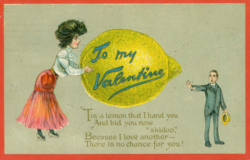A Sour Alternative; The History of the Anti-Valentine
Although Victorian society seemed to be prim and proper from our modern perspective, Victorians certainly had their share of mischief. Each year on Valentine’s Day, countless gifts and cards would be interchanged. Many would be of the intricate, beautifully laced type; exchanged between lovers each year (Ponti). However, nearly half would express a different perspective on the holiday (Ponti).
Designed to insult, “vinegar valentines” were on the undesirable flipside of the charming and delicate cards that were seen as conventional (Ponti). These cards were originally referred to as “comic” or “mocking” valentines; the term “vinegar valentine” is modern coinage (Little). As described by Crystal Ponti, “[…] their grotesque drawings caricatured common stereotypes and insulted a recipient’s physical attributes, lack of a marriage partner or character traits.” There was a vinegar valentine handy to insult anyone on any basis, whether it be towards personal qualities or directed at a specific profession (Ponti). Along with a wide range of topics, these acrid valentines spanned over a large spectrum of impoliteness. Some valentines simply contained a few snide remarks directed at the receiver, while others reflected truly destructive and threatening messages (Little). Inviting the opportunity to insult one’s enemies while remaining anonymous (Ponti), these callous cards were delivered with varying intentions, be it playful, hostile, or outright menacing.
While most were specific to the holiday spirit of the fourteenth of February, vinegar valentines also evolved to become applicable to the historical circumstances. As the women’s suffrage movement increased in pervasivity during this time period, a few of these sour valentines adapted their messages accordingly (Ponti). As advocates called for women’s right to vote, a few of these valentines began to negatively target those that supported the movement (Zarrelli). According to Pollen, some of these cards “pointed out moral failings” of the time period (qtd. in Ponti). These ideologies likely expanded upon the circumstances occurring during this movement, as women suffragists were constantly ridiculed for their advocacies.
Why do we know so little about this facet of Victorian society? These cards, although often overlooked in the overall Valentine’s Day image, were a central aspect of the holiday in Victorian society. They help to shed light on the historical circumstances that were unfolding, as well as the clashing opinions that followed. As history continues to progress, however, it is clear in today’s society that the traditional chocolate and roses have gradually taken precedence over the infamous vinegar valentine.
References:
References:
Ponti, Crystal. “Victorian-Era ‘Vinegar’ Valentines Could Be Mean and Hostile.” History.com, A&E Television Networks, 10 Feb. 2020, www.history.com/news/victorian-valentines
-day-cards-vinegar.
Little, Becky. “Nothing Says ‘I Hate You’ Like a ‘Vinegar Valentine’.” Smithsonian.com, Smithsonian Institution, 10 Feb. 2017, www.smithsonianmag.com/history/nothing-says-i
-hate-you-vinegar-valentine-180962109/#:~:text=People%20sent%20vinegar%20valentines%20as,to%20be%20a%20modern%20description.&text=Printers%20mass%2Dproduced%20Valentine%20cards,vinegar%20variety%2C%20which%20were%20cheap.
Zarrelli, Natalie. “The Rude, Cruel, and Insulting ‘Vinegar Valentines’ of the Victorian Era.” Atlas Obscura, Atlas Obscura, 13 Feb. 2020, www.atlasobscura.com/articles
/vinegar-valentines-victorian



